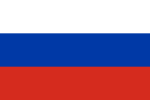Imperial Russian Army
| Imperial Russian Army Русская императорская армия |
|
|---|---|
 |
|
| Active | 1721–1917 |
| Country |
|
| Type | Army |
| Size | 12,000,000 during WW1 4,200,000 during Russian Civil War |
| Mascot(s) | |
| Engagements |
Great Northern War Russo-Turkish Wars Russo-Swedish Wars Russo-Persian Wars Russo-Polish Wars Seven Years' War Napoleonic Wars Caucasian War Crimean War Russo-Japanese War World War I Russian Revolution |
| Commanders | |
| Notable commanders |
Peter the Great Boris Sheremetev Alexander Menshikov Pyotr Rumyantsev Alexander Suvorov Grigory Potemkin Mikhail Kutuzov Pyotr Bagration Aleksey Yermolov Mikhail Skobelev Aleksei Brusilov |
The Imperial Russian Army (Russian: Ру́сская импера́торская а́рмия) was the land armed force of the Russian Empire, active from around 1721 to the Russian Revolution of 1917. In the early 1850s, the Russian army consisted of more than 900,000 regular soldiers and nearly 250,000 irregulars (mostly Cossacks).
The last living veteran of the Russian Imperial Army was the Ukrainian supercentenarian Mikhail Krichevsky, who died in 2008.
Russian tsars before Peter maintained professional hereditary musketeer corps, known as streltsy. These were originally raised by Tsar Ivan IV (Ivan the Terrible); originally an effective force, they had become highly unreliable and undisciplined. In times of war the armed forces were augmented by peasants.
The regiments of the new order, or regiments of the foreign order ("Полки нового строя" or "Полки иноземного строя", Polki novogo (inozemnogo) stroya), was the Russian term that was used to describe military units that were formed in Russia in the 17th century according to the Western European military standards.
There were different kinds of regiments, such as regulars, dragoons, and reiters. In 1631, the Russians created two regular regiments in Moscow. During the Russo-Polish War of 1632–1634, six more regular regiments, one reiter regiment, and a dragoon regiment were formed. Initially, they recruited children of the landless boyars and streltsy, volunteers, Cossacks and others. Commanding officers comprised mostly foreigners. After the war with Poland, all of the regiments were disbanded. During another Russo-Polish War, they were created again and became a principal force of the Russian army. Often, regular and dragoon regiments were manned with datochniye lyudi for lifelong military service. Reiters were manned with small or landless gentry and boyars' children and were paid with money (or lands) for their service. More than a half of the commanding officers were representatives from the gentry. In times of peace, some of the regiments were usually disbanded.
...
Wikipedia
